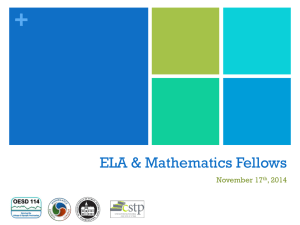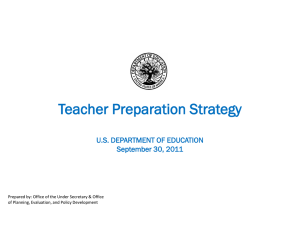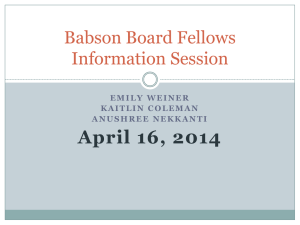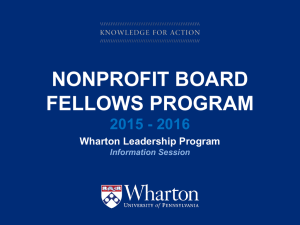A Case Study of Math for America Los
advertisement
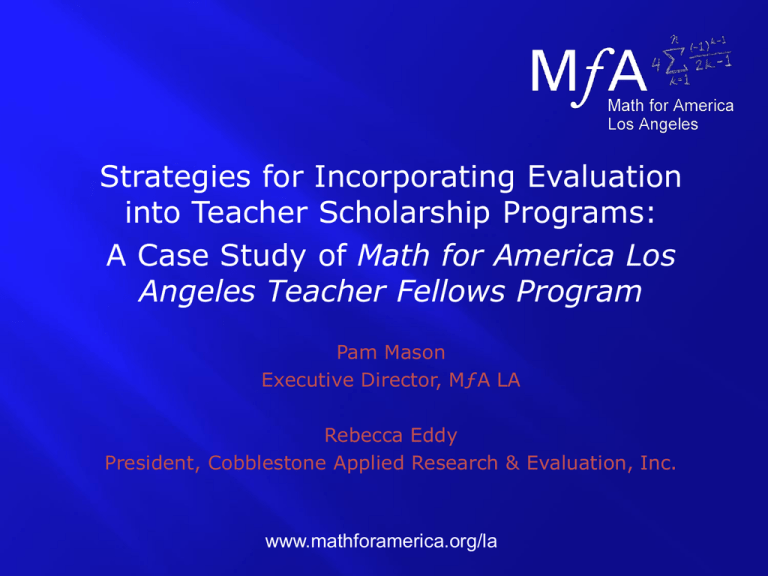
Strategies for Incorporating Evaluation into Teacher Scholarship Programs: A Case Study of Math for America Los Angeles Teacher Fellows Program Pam Mason Executive Director, MƒA LA Rebecca Eddy President, Cobblestone Applied Research & Evaluation, Inc. www.mathforamerica.org/la A Partnership of Mathematicians, Business People and Educators The mission of Math for America is to improve mathematics and science education in US public secondary schools by building a corps of outstanding STEM teachers and leaders. Our goal is to support those outstanding STEM teachers already in the classroom and to increase the number of mathematically talented individuals entering teaching. In 2008, The University of Southern California (USC), Claremont Graduate University (CGU) and Harvey Mudd College (HMC) teamed together with MƒA to create Math for America Los Angeles (MƒA LA). 2008 Cohort 2008 - 2012 Cohorts To improve math education in our public schools by attracting, training, and retaining highly qualified secondary school mathematics teachers. To provide the support teachers require to answer a critical need and bring about a real, sustained change. 2012 Master Teacher Cohort at PCMI • Ongoing classroom observations and instructional support by experienced advisors • Social and network building opportunities • Monthly Professional Development • Curriculum and Teaching Support • National Board Certification Clusters of Fellows at individual schools create effective learning environments for students Hawkins High School Montclair High School Miguel Contreras Learning Complex Alain Leroy Locke Senior High School Green Dot Public School James Monroe High School Helen Bernstein High School Fairfax High School Los Altos High School East Los Angeles Performing Arts Academy Ramon C. Cortines High School Professional Development Outreach Program Designed by Pam Mason, MƒA LA Executive Director Darryl Yong, Associate Chair of Mathematics at Harvey Mudd College Relevant, “Just in Time” Professional Development MƒA LA Fellows have attended regional and national conferences for mathematics teachers and have given formal presentations. Conferences attended during the 2012-2013 school year: • CMC South Conference in Palm Springs • CMC North Conference in Asilomar • NCSM Conference in Denver • NCTM Conference in Denver Photo by Solares Photography Reprinted with permission from the National Council of Teachers of Mathematics A tightly networked community •Regular meetings •Experienced coaches •Social events The MƒA LA Effect … ACCORDING TO MƒA LA COACHES “… a feeling of camaraderie …” Purpose of Evaluation Setting goals Identifying indicators to measure program implementation and outcomes Keeping the program on track Drawing conclusions about the merit of the program Evaluation designed to answer key evaluation questions Uses a combination of qualitative and quantitative methods Quasi-experimental design to compare students of MfA LA Fellows vs. students on non-Fellows in the same schools Evaluation Question To what extent is the implementation of MfA LA program activities occurring as planned? How well have Fellows’ students performed on mathematics achievement outcomes such as CST scores compared to other students? Do students of Fellows show any additional benefits from being in their classrooms such as course-taking patterns or attitudes about mathematics in comparison to students of non-Fellows? Are there differences between the Fellows’ experiences for those at cluster sites versus individual sites? Is there evidence that the MfA LA program improves teacher recruitment, quality, and retention in the teaching profession? What are the strengths of the MfA LA program? What are areas of improvement for MfA LA? Math for America Los Angeles is committed to a comprehensive evaluation of its programs and operations Purpose Track program implementation and measure outcomes Design Mixed method: Quantitative and qualitative data sources to answer evaluation questions Matched control group quasiexperimental design for student achievement data Evaluation Activities Focus groups, interviews, classroom observations, document analysis, assessment of student test scores & surveys • • What is a logic model? Common elements in a logic model: • • • • Inputs Activities Outputs Outcomes “Logic models help us plan, implement, evaluate, and communicate more effectively.” Taylor-Powell, E., & Henert, E. (2008) • University of Wisconsin – Extension: templates, examples http://www.uwex.edu/ces/pdande/evaluation/evallogicmodel.html • W. K. Kellogg Foundation: Development Guide http://www.wkkf.org/knowledge-center/resources/2006/02/wk-kelloggfoundation-logic-model-development-guide.aspx H E A D A C H E Situation Get Pills Take Pills INPUTS OUTPUTS Feel Better OUTCOMES MfA LA Teacher Fellows Program Logic Model Outputs Inputs What is invested in MfA LA Situation Students underachieve in math; U.S. needs STEM workforce to be globally competitive Staff Exec. Director Coaches Financial Support (Grants, Donors) Time Cred. Program Activities What MfA LA does Fellows receive stipends + tuition support Fellows receive coaching from mentors Fellows receive prof. support through PD Fellows receive moral/ emotional/ instructional support from other Fellows Fellows teach in classrooms/ work in math depts Participation Who MfA LA reaches Fellows receive training Teachers at Fellows’ school collaborate with Fellows Students receive math instruction from trained Fellow Schools receive trained teachers/ leaders Districts receive trained teachers Assumptions Highly qualified math teachers produce high achieving students Recruiting, training & supporting highly-qualified individuals will produce highly qualified teachers who stay in the profession Outcomes Short-term Fellows have improved pedagogical skills Med-term Fellows continue to teach in schools Fellows maintain content knowledge in math Students acquire strong math skills Fellows feel supported & respected as a teacher Students maintain achievement & interest in math/ other STEM fields Fellows are more confident to lead in classroom & in department National Board Certification & continued professional growth Long-term Fellows retained in math profession LA schools/ districts have highly qualified math teachers LA schools/ districts have high achieving math students Students from LA competitive in global economy External Factors Students in high poverty schools in LA less likely to receive instruction from highly qualified teachers Students in high poverty schools in LA less likely to perform well in mathematics Outputs Need Inputs What needs are we addressing? Teachers lack support and professional development experiences that prevents recruitment & retention of highquality mathematics secondary school teachers Activities Participation Product Outcomes Short-term Long-term Outputs Need Inputs What resources do we need for the program? Director/ staff expertise, funding Activities Participation Product Outcomes Short-term Long-term Outputs Need Inputs Monitoring Implementation Activities Participation Product What activities are planned to address the needs? Who will participate? Fellows attend monthly PD sessions 10 months per year & attend professional conferences; receive coaching support; stipends Outcomes Short-term Long-term Outputs Need Inputs Activities Participation Product Determining Program Merit Outcomes Short-term Long-term What are the shortterm and long-term changes we expect to see in participants? Fellows acquire content knowledge, classroom management & planning skills (short-term) Fellows are retained in the profession & are effective secondary math teachers (long-term) See the following list and determine in which category each applies For example: Bake cookie dough Is this a need, activity, outcome, etc.? 1. Start with a need 2. Identify one activity (Outputs) • Specify how much of that activity needs to happen to address the need (Activities) • Establish who will be reached by the activity and what is required of their participation (Participation) 3. What resources are required? (Inputs) 4. What is your goal for meeting the needs? (Outcomes) What are some common needs that you identified? In thinking about designing an evaluation, what are some indicators that we will track? Outputs Outcomes How can we design an evaluation to effectively address the key evaluation questions and include the indicators for implementation and outcomes? Evaluation Question To what extent is the implementation of MfA LA program activities occurring as planned? How well have Fellows’ students performed on mathematics achievement outcomes such as CST scores compared to other students? Do students of Fellows show any additional benefits from being in their classrooms such as coursetaking patterns or attitudes about mathematics in comparison to students of non-Fellows? Are there differences between the Fellows’ experiences for those at cluster sites versus individual sites? Is there evidence that the MfA LA program improves teacher recruitment, quality, and retention in the teaching profession? What are the strengths of the MfA LA program? What are areas of improvement for MfA LA? Answer Implementation: Main activities were implemented as planned (e.g., PD, coaching); Slight adjustments to coaching and professional development to meet the needs of more experienced Fellows CST: Fellows’ students performed similarly to a matched group of students of non-Fellows across all subject areas CAHSEE: Fellows’ students performed similarly to students of non-Fellows; 11th grade students of Fellows were more likely to pass than students of non-Fellows Course-Taking Patterns: Students of Fellows (57%) were more likely to advance to another math class in the next school year than students of non-Fellows (51%) for both years (2010/11 & 2011/12) Student Attitudes: At pretest, students of Fellows and non-Fellows had similar attitudes towards mathematics; fall survey to be administered and analyzed to determine if there are differences at posttest Fellows at “cluster sites” reported more support, lesson collaboration, and similar philosophies about teaching than Fellows at “individual sites” Recruitment: Some Fellows reported that MfA LA provided additional motivation to enter the teaching profession Retention: 97% of Fellows have been retained; 91% of Fellows plan to stay in teaching field after MfA LA Teacher Quality: Fellows have strong academic backgrounds (i.e., Praxis, college major) and build from this basis as indicated by coaches comments & classroom observations Program Strengths: Professional and Community Support; Quality of Program Activities (e.g., PD, workshops); Financial Support Professional Development: Lesson planning; Small-group discussions Coach-Fellow Mentoring Model: Critical and constructive feedback from coaches; Clarification of coaches’ roles; Training for coaches 2009 Cohort “I am very thankful for all that MƒA LA has been done to make me a better teacher.” 2009 Cohort “I am grateful for such a wonderful chance to inspire young minds ...” 2009 Cohort “I always consider it an honor to say that I am a fellow in such a wonderful organization Renewing and expanding our commitment to improve student achievement and mathematics education in the greater Los Angeles community with each new cohort of fellows.
